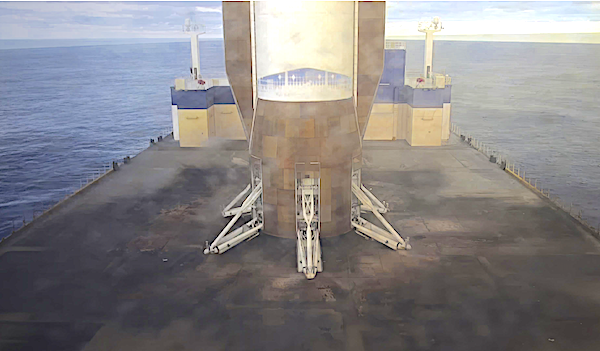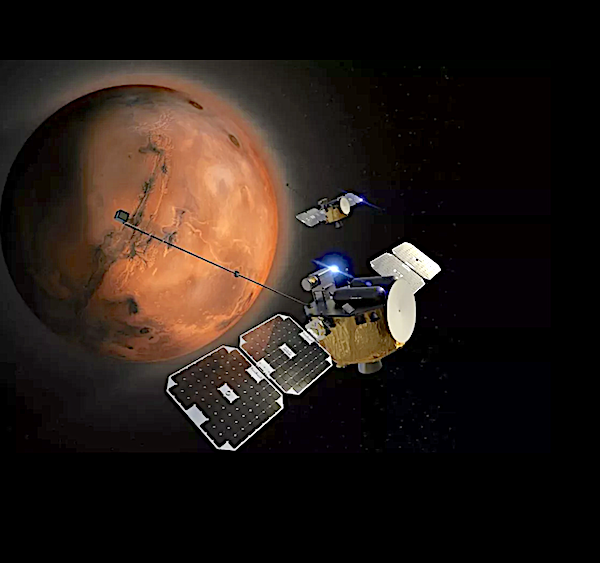
The New Glenn orbital launch vehicle successfully completed its second mission, deploying NASA’s Escape and Plasma Acceleration and Dynamics Explorers (ESCAPADE) twin-spacecraft into the designated loiter orbit, and landing the fully reusable first stage on Jacklyn in the Atlantic Ocean. Photos captured by Satnews.
New Glenn’s seven BE-4 engines ignited on Thursday, November 13, 2025, at 3:55:01 PM EST / 20:55:01 UTC from Launch Complex 36 at Cape Canaveral Space Force Station.
“We achieved full mission success today, and I am so proud of the team,” said Dave Limp, CEO, Blue Origin. “It turns out Never Tell Me The Odds had perfect odds—never before in history has a booster this large nailed the landing on the second try. This is just the beginning as we rapidly scale our flight cadence and continue delivering for our customers.”

The ESCAPADE spacecraft will begin their journey to Mars once the planets have returned to the ideal alignment in fall 2026. ESCAPADE will use two identical spacecraft to investigate how the solar wind interacts with Mars’ magnetic environment and how this interaction drives the planet’s atmospheric escape. In addition to deploying the NASA spacecraft, the Viasat HaloNet demonstration onboard New Glenn’s second stage successfully executed the first flight test of Viasat’s telemetry data relay service for NASA’s Communications Services Project.
“Congratulations to Blue Origin, Rocket Lab, UC Berkeley, and all of our partners on the successful launch of ESCAPADE,” said the acting NASA Administrator, Secretary Sean Duffy. “This heliophysics mission will help reveal how Mars became a desert planet, and how solar eruptions affect the Martian surface. Every launch of New Glenn provides data that will be essential when we launch MK-1 through Artemis. All of this information will be critical to protect future NASA explorers and invaluable as we evaluate how to deliver on President Trump’s vision of planting the Stars and Stripes on Mars.”

New Glenn is foundational to advancing our customers’ critical missions and our own. The vehicle underpins our efforts to establish sustained human presence on the Moon, harness in-space resources, provide multi-mission, multi-orbit mobility through Blue Ring, and establish destinations in low Earth orbit.
The New Glenn program has several vehicles in production and multiple years of orders. In addition to NASA and Viasat, customers include Amazon’s Project Kuiper, AST SpaceMobile, and several telecommunications providers, among others. The mission marked the vehicle’s second National Security Space Launch (NSSL) certification flight. Blue Origin is certifying New Glenn with the U.S. Space Force for the NSSL program to meet emerging national security objectives.
“Today was a tremendous achievement for the New Glenn team, opening a new era for Blue Origin and the industry as we look to launch, land, repeat, again and again,” said Jordan Charles, Vice President, New Glenn. “We’ve made significant progress on manufacturing at rate and building ahead of need. Our primary focus remains focused on increasing our cadence and working through our manifest.”
Blue Origin’s New Glenn to carry EscaPADE the first multi-spacecraft orbital science mission to Mars on Wednesday


Blue Origin’s second flight of New Glenn launch vehicle carrying the Escape and Plasma Acceleration and Dynamics Explorers (EscaPADE), a dual-spacecraft mission with University of California, Berkeley’s Space Sciences Laboratory to study ion and sputtered escape from Mars on Wednesday from Launch Complex 36A, Cape Canaveral SFS, from 11:50 AM – 1:17 PM PST.
The spacecrafts’ scientific goals are to understand the processes controlling the structure of Mars’ hybrid magnetosphere and how it guides ion flows; understand how energy and momentum are transported from the solar wind through Mars’ magnetosphere; and understand the processes controlling the flow of energy and matter into and out of the collisional atmosphere.
To achieve this mission Escape’s twin orbiters will take simultaneous observations from different locations around Mars, and the observations will reveal the planet’s real-time response to space weather and how the Martian magnetosphere changes over time.
ESCAPADE will analyze how Mars’ magnetic field guides particle flows around the planet, how energy and momentum are transported from the solar wind through the magnetosphere, and what processes control the flow of energy and matter into and out of the Martian atmosphere.
The ESCAPADE mission is managed by the Space Sciences Laboratory at the University of California, Berkeley, with key partners Rocket Lab, NASA’s Goddard Space Flight Center, Embry-Riddle Aeronautical University, Advanced Space LLC, and Blue Origin.
